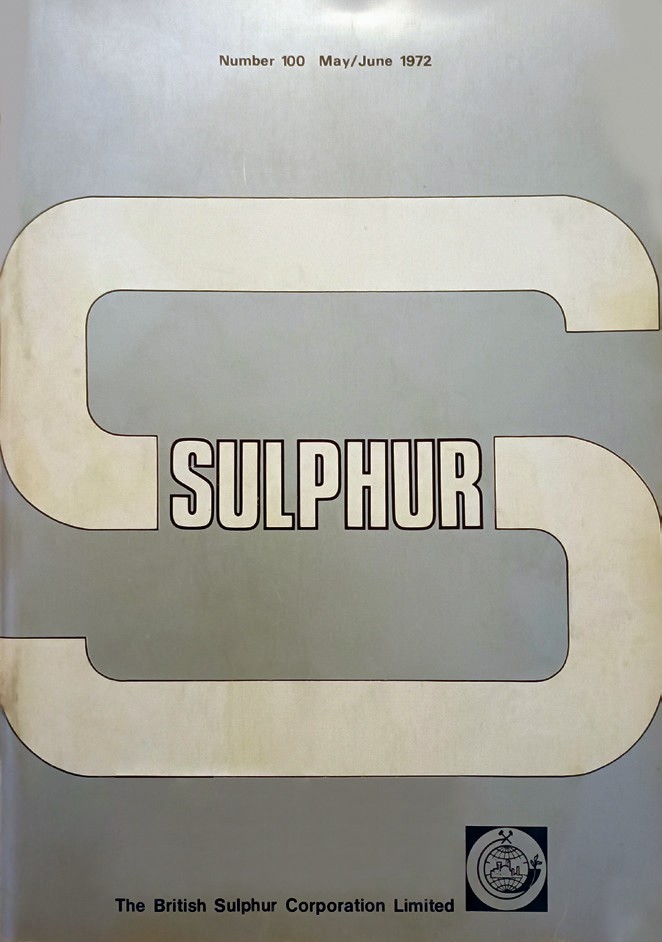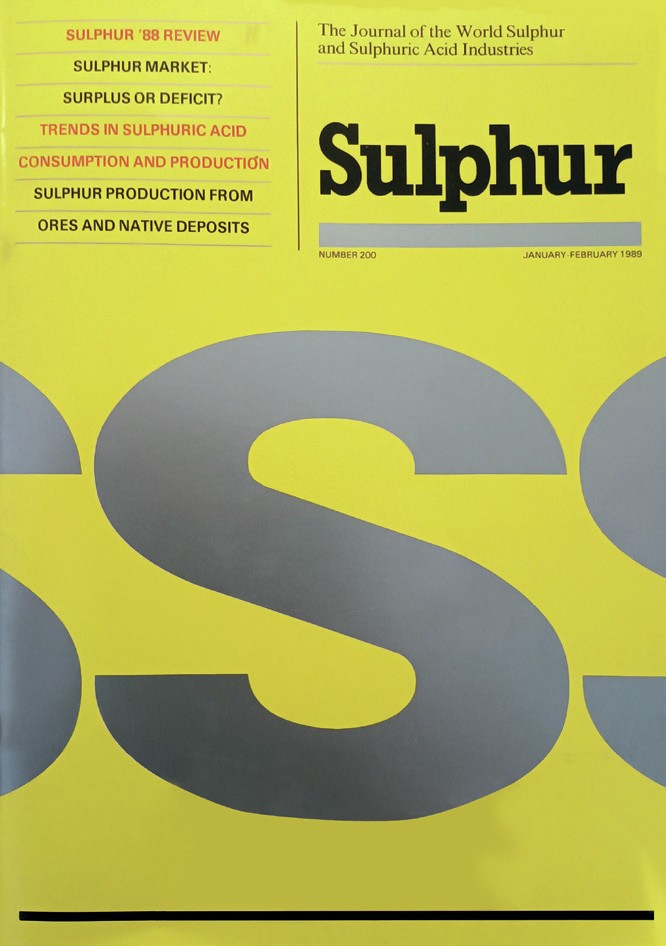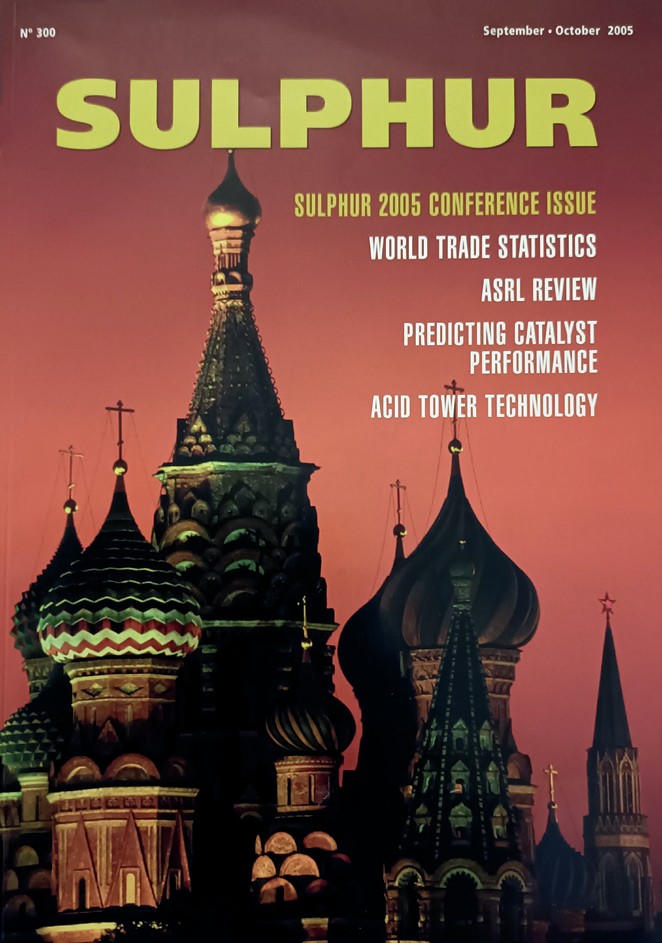Sulphur 400 May-Jun 2022

31 May 2022
Sulphur at 400
SULPHUR MAGAZINE
Sulphur at 400
This is the 400th issue of Sulphur magazine, now in its 69th year. From its beginnings as the Quarterly Bulletin of the Sulphur Exploration Syndicate, it remains the only magazine dedicated to both the sulphur and sulphuric acid industries.



Sulphur began its existence in 1953 as the Quarterly Bulletin of the Sulphur Exploration Syndicate.The Syndicate represented nine chemical producers, mainly in Britain and the US, who were concerned about dwindling world supplies of sulphur; F.W. Berk and Co.Ltd, British Titan Products, Brotherton & Co., Courtaulds, Dunlop Rubber, Fisons, Laporte Chemicals, Monsanto Chemicals, and Charles Tenant & Sons Ltd. It was formed in the wake of a ‘sulphur crisis’ in 1950-51, when a global shortage of sulphur led to the setting up of the International Materials Conference, which instituted a world-wide system of sulphur ‘rationing’ in the western world that lasted into 1953.
The Syndicate aimed to provide “accurate technical, economic, statistical and price information” on the world sulphur industry as global sulphur consumption increased rapidly, and also to examine new sources of sulphur. At that time, the global market for elemental sulphur only amounted to just under 13 million t/a, most of it (90%) produced in the United States and Gulf of Mexico from Frasch mining, and mostly destined for industrial sulphuric acid use. However, this figure was on the cusp of rapid expansion as the modern phosphate industry was created. At the same time, the use of pyrites to manufacture sulphuric acid, which had been the predominant method to that time, was also coming to be overtaken by the burning of sulphur via the Contact Process. But that led to concerns about whether there was enough sulphur identified in underground deposits to meet projected future needs.
The Syndicate and the magazine were the brainchild of John Lancaster, the founder of the British Sulphur Corporation, which published the Bulletin, soon to be renamed Sulphur Magazine. Lancaster’s name was an anglicisation of his birth name – he was a refugee from Czechoslovakia after its takeover by Nazi Germany in 1938, and had served with the British Army in WWII as an intelligence officer, charged with sourcing key raw materials for the war effort. This in turn led to his preoccupation with sulphur and where it might be found.
Sulphur 100
By the time it reached its 100th issue, in 1972, Sulphur was being produced at the British Sulphur Corporation’s offices at Parnell House near London’s Victoria Station. Fertilizer demand was growing rapidly as India and South America experienced their ‘Green Revolution’, and the sulphur industry was growing with it – fertilizer demand for sulphur tripled from 1952-72 from 5 million to 15 million t/a as the US phosphate industry boomed. However, production was now outpacing demand, as Canada’s sour gas industry rapidly ramped up sulphur recovery, reaching 8 million t/a in 1972, and with the USA and France’s own sour gas extraction not far behind. Controls on SO2 emissions from smelters were also starting to see large volumes of excess acid being recovered, especially in Japan. With a surplus from involuntary production looming, it was slightly amusing for me to read an article in issue 100 on new uses for sulphur, which listed sulphur asphalt, concrete and sulphur polymers – a topic which seems to remain a perennial one even 50 years later, though now, as then, without every quite seeming to achieve a breakthrough.

Sulphur 200
Published in 1989, Sulphur’s 200th edition, now with the familiar yellow cover, carried an editorial from John Lancaster himself (always referred to at British Sulphur as ‘JML’) reviewing the sulphur industry. Global demand for sulphur in ‘all forms’(i.e. including smelter and pyrite acid) had now reached 60 million t/a, with sulphuric acid production reaching 155 million t/a. More sulphur from sour gas was now coming from the USSR with its Astrakhan and Tengiz plants, though the US continued to develop new Frasch mines. Sulphur prices at Vancouver – then exporting 5 million t/a via the Cansulex consortium – stood at around $100/tonne.
Sulphur 300
Sulphur’s 300th edition came in 2005, its cover highlighting the Sulphur 2005 conference in Moscow, and this time carries a guest editorial from its new publisher, John French. The British Sulphur Corporation had by then been bought up by CRU, though Lisa Connock then as now was Technical Editor and Tina Firman Advertisement Manager, and there were contributions from names which must surely be familiar to longer-term readers such as Mike Kitto, Peter Clark, Jim Hyne, Jerry D’Aquin and Lou Doerr. The increase in consumption of ‘sulphur in all forms’ had slowed from the heady days of the 1970s and 80s, but had still reached 70 million t/a, of which 46 million t/a was represented from elemental sulphur, now 98% produced from refineries and sour gas processing. The intervening years had seen the rise of premium sulphur forming techniques for better product quality, and a move away from the liquid sulphur transportation and trade that had characterised the 1970s and 80s, as well as increasingly stringent regulations on emissions of sulphur, especially from vehicles that had boosted the refinery component of recovered sulphur. Sulphuric acid consumption reached 190 million t/a, with the onset of demand from new high pressure acid leach plants for nickel recovery.
Sulphur 400
And so we come to today, with BCInsight having taken on the British Sulphur fertilizer titles – Nitrogen+Syngas, Fertilizer International, and of course Sulphur, though with most of the same team producing them. The sulphur industry continues to evolve, with sour gas from the Middle East now eclipsing the declining fields of Europe and Canada, and fuel regulations continuing to tighten as the refining industry shifts from North America and Europe to Asia and the Middle East. Sulphur production in all forms has now topped 80 million t/a, and the need for phosphate continues unabated, while metals like nickel and lithium are seeing a boost in demand from the world’s move towards electrification and more use of batteries. We may be at nor near peak oil production, and more changes are doubtless ahead for the industry. It has been my own great privilege to be the magazine’s editor for the past 13 years, and who knows, perhaps to be compos mentis enough to contribute to Sulphur’s 500th edition, some time around 2039.






